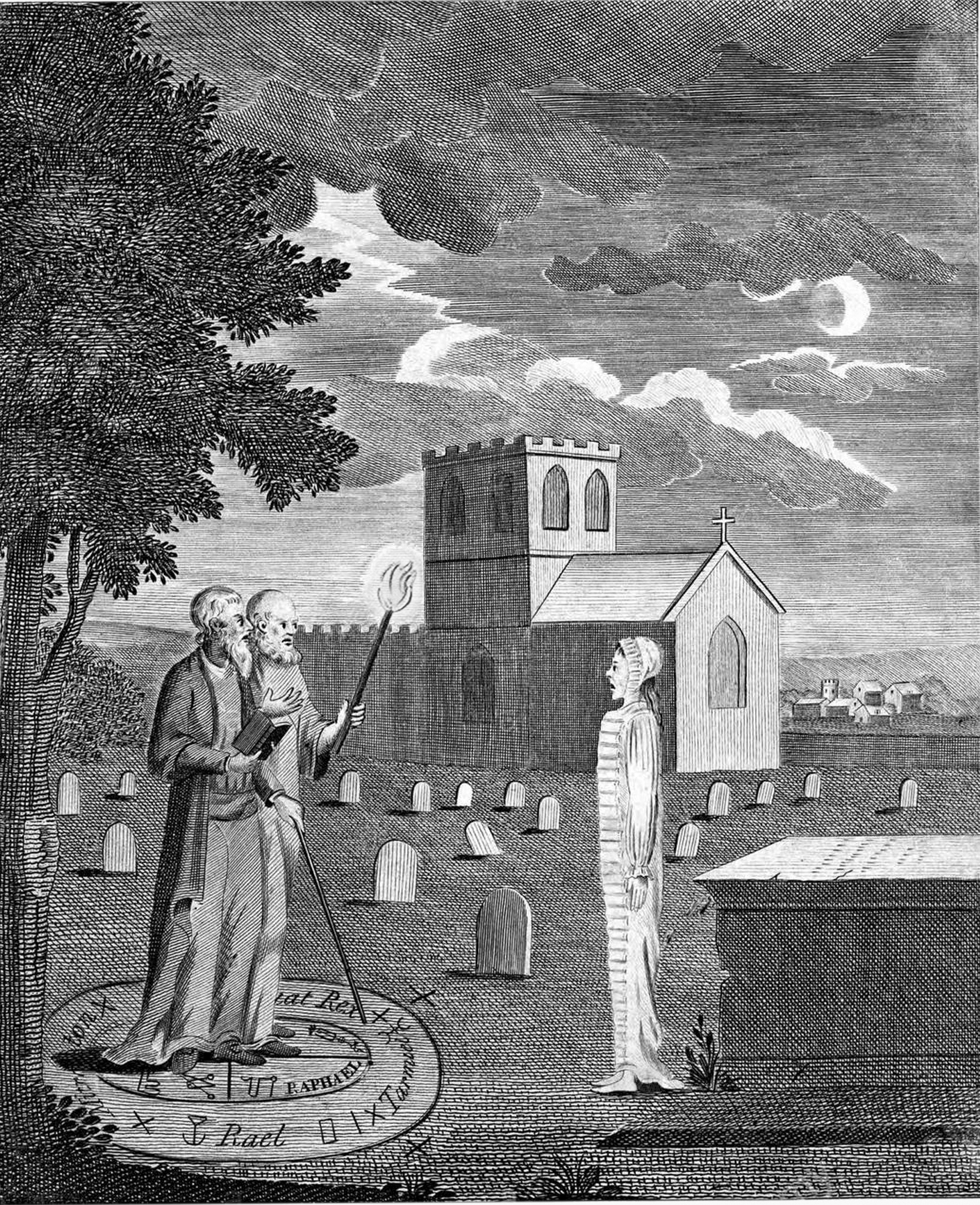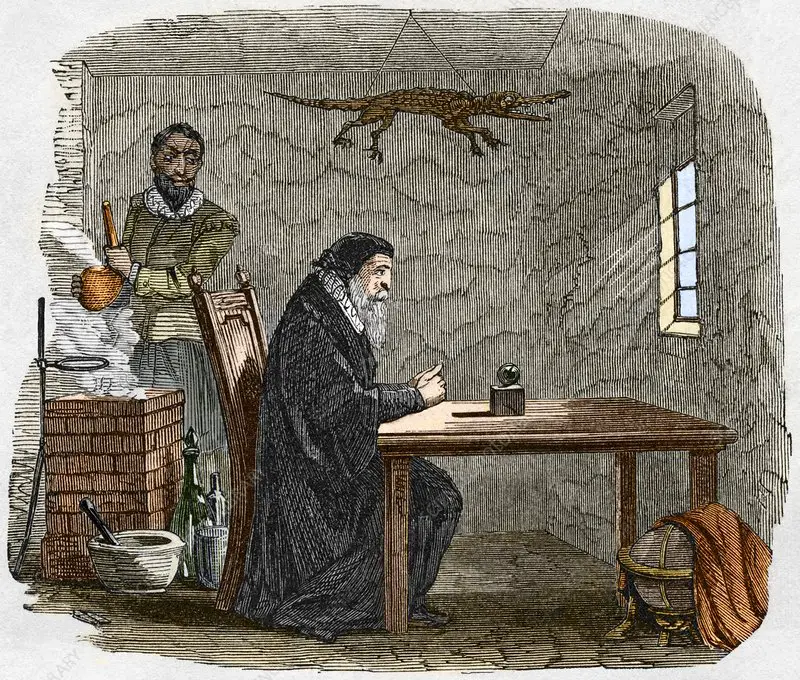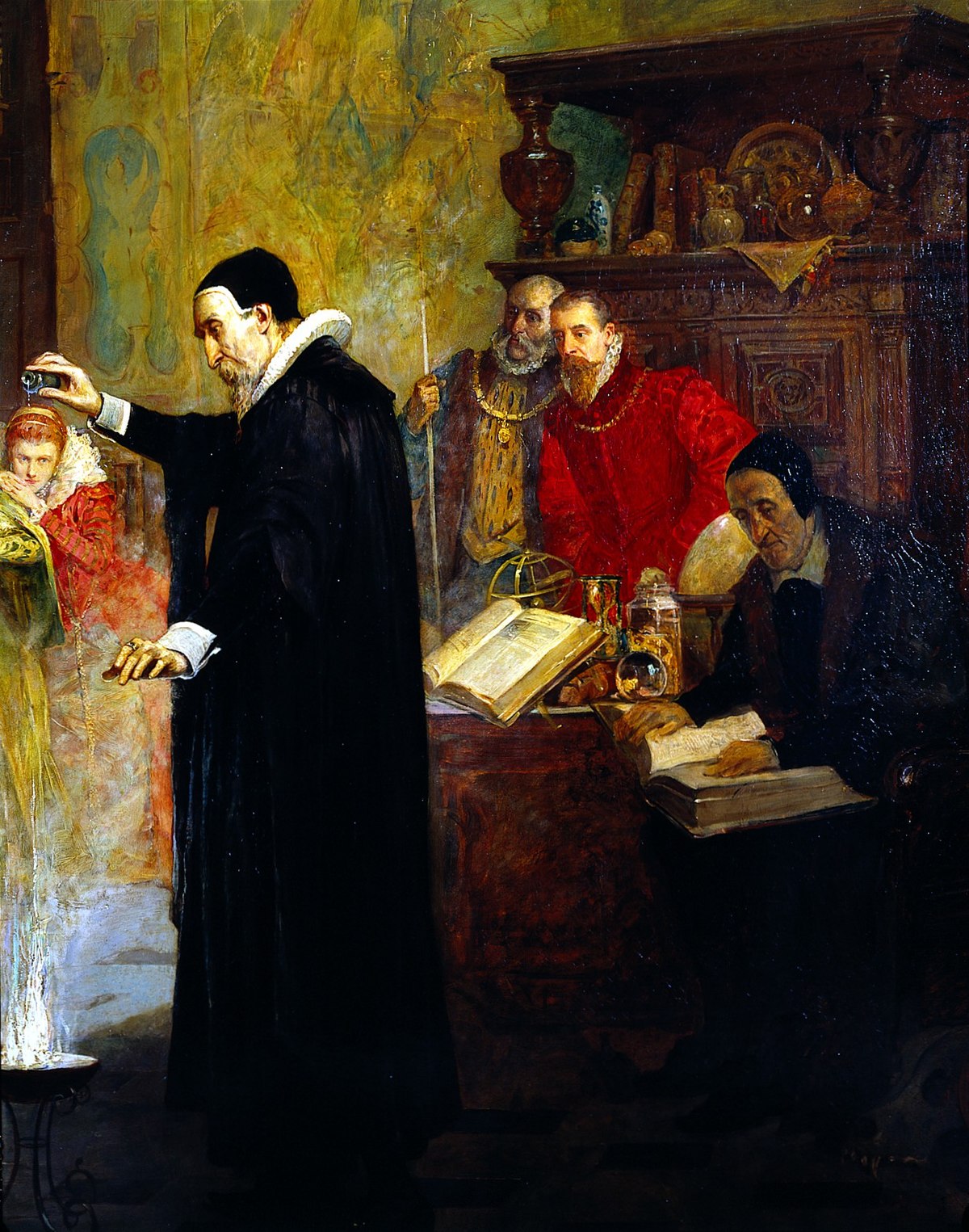John Dee's Story: English mathematician, scientist and astrologer who pursued the secret language of angels, the Enochian.
di Laura Tripaldi
originally published on The Indiscreet
In his story The Library of BabelJorge Luis Borges describes a boundless archive of books whose librarians are forced to live as prisoners, wandering from one hexagonal room to another with no way out but a vertical well that falls into thin air. The library shelves are filled with volumes containing entirely random sequences of letters, and whose meaning, if they have one, is completely obscure to their hapless readers.
Sometimes, among the endless pages of alien words, expressions of some known language appear; it is assumed that the library contains every possible combination of 25 alphabetic characters, distributed in volumes of 410 pages of 1600 characters each, and that, in one of the countless shelves, there is also a book capable of revealing the mystery of the library itself.
In any case, the probability of that book being found is so negligible that its existence, like that of any other volume, is statistically completely insignificant. The architect of this immense labyrinth is perhaps a demiurge endowed with boundless perversity; yet, the apparent chaos of the library seems to recall a superior divine order, however completely incomprehensible to the minds of men.
“Man, this imperfect librarian, can be the work of chance or of malevolent demiurges”, writes Borges, “the universe […] can only be the work of a god. To feel the distance between the divine and the human, it is enough to compare these rough, tremulous symbols that my fallible hand scrapes on the cover of a book, with the organic letters of the interior: punctual, delicate, very black, inimitably symmetrical ".
Moreover, the city of Babel, with its swarming of fragmented and incomprehensible languages, is the sign of man's ruinous fall from his original linguistic and spiritual communion with God; the librarians, tireless researchers, wander among the debris of this ancient catastrophe, in hope - perhaps vain - to understand the original form of the lost divine word.

Certainly, Borges was influenced, in this as in many other tales, by a vast tradition of ancient mystical and magical doctrines, at the heart of which is the idea that the transformation of words through permutation processes can reveal a network of occult and powerful connections. A branch of Jewish Kabbalah known as temurah, whose most illustrious exponent was the mystic Abraham Aboulafia, was based precisely on the practice of combining and permuting the Hebrew letters of the Torah and the sacred names of God, producing a series of formulas capable of expressing, in their continuous change, the divine power and the splendid harmony of the cosmos. This idea is illustrated by Gershom Scholem in Kabbalah and its symbolism, where he explains that, according to the doctrine of Aboulafia,
“The basic elements, the name JHWH, the other names of God and the appellations o kinnuyim they were transformed by permutations and combinations of consonants […] until they finally appeared in the form of the Hebrew phrases of the Torah, as we read them now. The initiates, who know and understand these principles of permutation and combination, can follow the reverse path, from the text backwards, and reconstruct the original fabric of the names "with the aim of going back" to the secret work of divine power " .
Doctrines such as this exerted an incalculable influence on the Renaissance thought, in which mysticism, magic and mathematics came together to form what is now universally known as hermetic tradition. The influence of this magical thought on the development of modern culture was long neglected, until, starting from the second half of the last century, it was finally rehabilitated by various scholars and academics, among which, above all, the research of the historian Frances Yates.
Perhaps the most enigmatic and obscure product of this multifaceted current of thought is the Enochian system by John Dee. John Dee was a mathematician, scientist and astrologer in the service of the court of Elizabeth I, whose career was, after all, that of a respectable intellectual of the time. In the course of his life he composed several scientific and mathematical works which met with widespread success; he entered into the good graces of Elizabeth I for having composed, in 1555, a horoscope in which he predicted his next accession to the throne. When Elizabeth became queen, she was granted the opportunity to continue her studies independently, under the tutelage of the crown.
But, starting in 1582, John Dee's research took an increasingly eccentric turn. Influenced by the works of other intellectuals of the time, and perhaps dissatisfied with the answers offered by the science of his day, John Dee began to deal with magic and spiritism, with the aim of penetrating, using more or less orthodox methods, the ultimate mysteries of the cosmos. In this endeavor, he was joined by a young alchemist of questionable reputation named Edward Kelley, who showed up at his home in Mortlake revealing an incredible talent as a medium.

According to the testimonies contained in Dee's diaries, Kelley was able to communicate, with the help of a quartz crystal, with invisible spiritual entities. The spirits contacted by Kelley during his séances with Dee, who presented themselves in the guise of angels and archangels, soon began to make ever more exuberant claims, forcing the two to travel incessantly across Europe to convey the angelic message to the rulers of the time. Gradually, the angels began to pass on the fragments of what it looked like a complex, but indecipherable, cryptographic system, made up of abstruse seals and endless grids of letters.
The angels revealed to Dee and Kelley an unknown language, called by Dee Enochian language, consisting of an alphabet of twenty-one characters, in which nineteen 'keys' were composed similar to evocation spells with a mysteriously apocalyptic content. The turbulent friendship between Dee and Kelley ended abruptly in 1587, and with it also ended John Dee's angelic communications. Evidence of their exploits remains a large collection of diaries and manuscripts, the first publication of which dates back only to 1659, when a part of Dee's diaries, containing a detailed report of his communications with the angels, was accidentally found by an antiquarian and was date to the press.
The legacy of John Dee's work is controversial, and the study of his angelic conversations has had a history that is anything but linear. What makes Dee's approach to work particularly insidious is above all the vast constellation of scholars who have dealt with it, heterogeneous and with often incompatible interests, which testifies, moreover, the richness of his thought. From the early years of the twentieth century, Dee's work became the beating heart of what the writer Kenneth grant would have renamed the awakening of magic: a current of contemporary English esotericism that started from theHermetic Order of the Golden Dawn, a Rosicrucian-Masonic secret society that mixed John Dee's angelic system with pseudo-Egyptian ceremonial forms of magic.
In particular, the scholar and esotericist Samuel Liddel MacGregor Mathers he recovered the manuscripts of Dee, at the time completely neglected by academics, spreading them among the initiates as the basis of a new dogma of ceremonial magic. In the footsteps of Mathers, it was Aleister Crowley, the most important esotericist of the twentieth century, to further popularize the Enochian material among the followers of the occult. As documented in the book The Vision and The Voice, in 1909 Crowley traveled the Algerian desert reciting the thirty angelic invocations that would have allowed him to access as many states of mystical ecstasy. These levels of enlightenment, which Dee defines Aethirs, are populated with visions charged with that magical symbolism that characterizes Crowley's entire work, in a surprising mix of numerology, Egyptian mythology and apocalyptic iconography.

Faced with such a legacy, it is easy to overlook John Dee's writings as another unimportant expression of occult junk. Also for this reason, various scholars, starting from the second half of the last century, have undertaken to rehabilitate Dee's work, contextualizing it within the thought of his time. Dee's Enochian writings are, to all intents and purposes, magical works, in the sense that they fully belong to the hermetic tradition of his time; after all, Dee was in possession of one of the richest libraries in Europe, and was aware of the writings of the most important exponents of Hermeticism, including the From Occulta Philosophia by Heinrich Cornelius Agrippa, one of the most complete and influential magic texts of the Renaissance.
Many of the writings that inspired Dee contain a curious mixture of demonology and cryptology; the most relevant example is certainly the mysterious Book of Soyga, a bizarre grimoire consisting of 36 pages of apparently incomprehensible letter arrays, which were only deciphered in recent years, revealing a complicated cryptographic algorithm. The influence of this material is reflected in the complexity of the Enochian system of evocation, which, in accordance with the Neoplatonism of the time, uses a geometric-mathematical approach to communicate with the angelic hosts.
John Dee's magic, as well as his life story, is deeply melancholy. The goal of Dee's magical operation was explicitly that of rebuild a lost language; it is the language that was revealed, according to the apocryphal doctrines, to the biblical patriarch Enoch, capable, like the divine word of Genesis, of working miracles. In the angelic experiments of Edward Kelley and John Dee, the religious idea of a lost paradise was concretized, which, however, was not a forgotten place or time, but which had the form of an original universal language, one Adamic language capable of uniting the peoples of the Earth in a new communion with the divine.
This emerges clearly in several angelic communications, in which the Enochian language is presented as a divine gift to humanity plunged into sin and ignorance. Unfortunately, Dee's dream of reuniting humanity under the banner of a universal language crashed ruinously, as happened to other contemporary philosophers, first of all Giordano Bruno, against the repressive violence of the Counter-Reformation. In this regard, Frances Yates' commentary on Dee's work in her essay is significant Kabbalah and Occultism in the Elizabethan Age:
“I'm not interested here in the search for the sensational that has polarized around the Dee e which has tended to obscure its real meaning: its importance consists, in my opinion, in the presentation, through the life and work of a man, of the phenomenon of the dissolution of the Renaissance, in the late sixteenth century, among the gloomy rumors about the devil. What happened during Dee's lifetime to her "Renaissance Neo-Platonism" occurred all over Europe at the stage when the Renaissance sank into the darkness of the witch hunt. "

The same spirits with whom Dee and Kelley had their conversations often appear cold and calculating, so distant that they are indifferent to human concerns. Their revelations came piecemeal, and painstakingly transcribed, often communicated one letter at a time with the help of huge encrypted tables. Whether or not one chooses to believe that Kelley's visions were a genuine phenomenon of spiritism, it is indubitable that John Dee attempted, with all his skills and knowledge, to derive a unitary system of the universe on the basis of the information that was transmitted to him, but never really succeeding.
This fate of a cursed magician is certainly one of the greatest elements of charm in the life and work of John Dee, who, however, must not distract us from the rigor of his research in an era in which contemporary science had not yet seen the light, and in which, faced with the violence of religious persecutions, many hoped that a universal mystical message such as the Hermetic-Neoplatonic one could restore humanity to a lost age of peace and splendor.
Leaving behind the esoteric projects of spiritual restoration of the Golden Dawn and the apocalyptic visions of Aleister Crowley, it is legitimate to ask how one can approach Dee's work with a contemporary sensitivity, without uprooting it from the cultural context of his time but without neglecting, at the same time, its profoundly magical and mystical character. Popular culture is still fascinated by angels as a mythical representation of an alien intelligence; Dee's work was undoubtedly one of the major influences in the construction of this one new angelic bestiary.
The most strictly semiotic aspect of Dee's work, namely the search for a universal language capable of overcoming the barriers of symbolic language, is an incredibly contemporary philosophical question: Dee and Kelley's linguistic experiments are a laboratory for transforming the human word into a code capable of shattering the symbolic order, drawing directly from the divine source of meaning. But what makes Dee's work above all modern is precisely the tragic and painful nature of his search; that of a Renaissance man on the last border of an era of certainties, who found himself bravely confronted with the indecipherable voices of a new aeon.


Very interesting and well written article. Thanks for sharing.
Thanks to you for your kind feedback, Paola